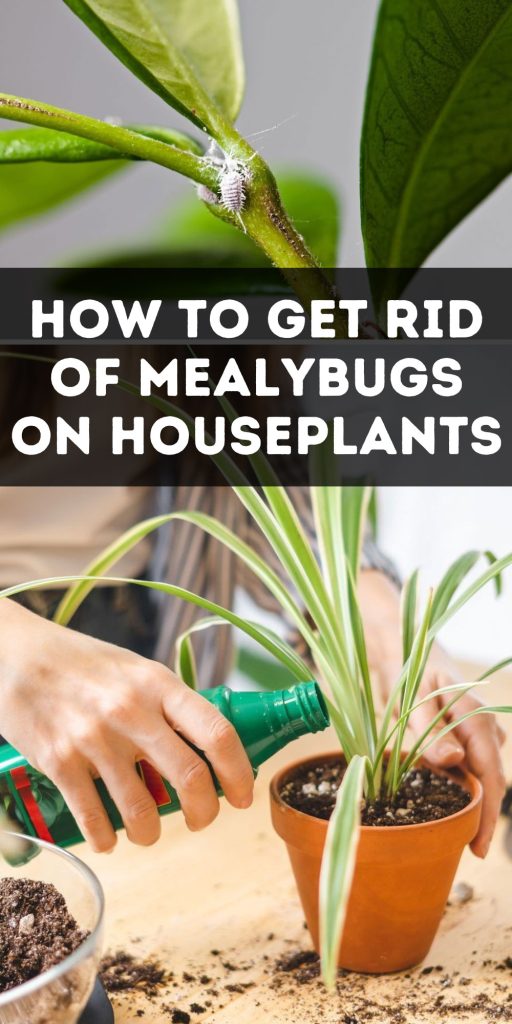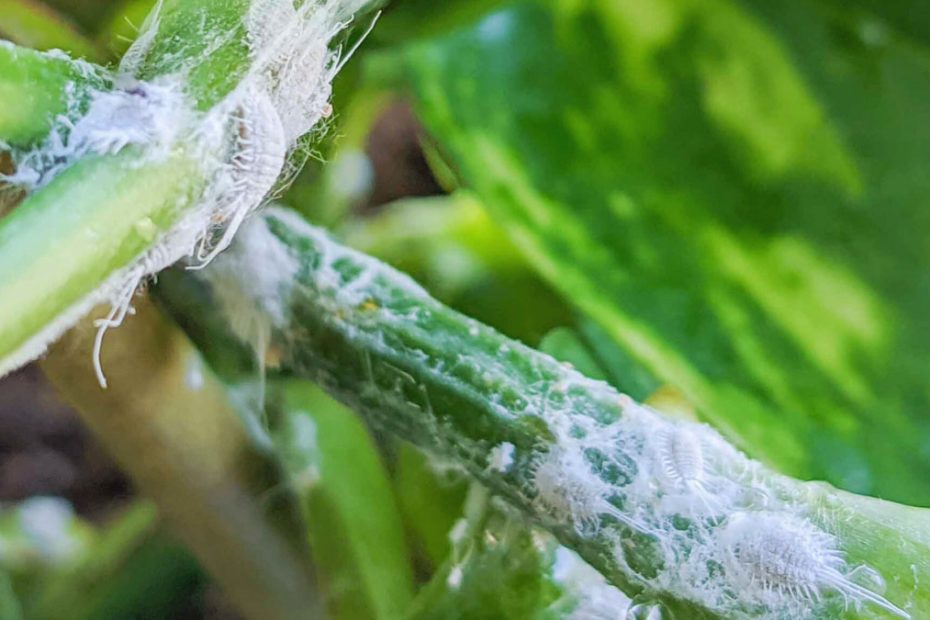Finding tiny, white, cotton-like pests on your beloved houseplants can be frustrating. These intruders are mealybugs, and they can quickly turn your green oasis into a nightmare if not addressed promptly. But don’t worry—you can reclaim your indoor garden with some straightforward strategies.
In this guide, you’ll learn effective methods to identify and eliminate mealybugs, ensuring your plants stay healthy and vibrant. Whether you’re a seasoned plant parent or just starting your indoor gardening journey, these tips will help you keep your houseplants pest-free.
Key Takeaways
- Identify Mealybugs Early: Look for white, cotton-like clusters and sticky sap (honeydew) on plants. Early detection prevents severe damage.
- Regular Inspection and Proper Care: Inspect plants, especially new additions, weekly. Provide balanced care, including proper watering and fertilization, to enhance plant resistance.
- Natural Remedies: Use rubbing alcohol, neem oil, and insecticidal soap to treat mealybugs naturally. These methods are safe for most houseplants and the environment.
- Chemical Solutions for Severe Infestations: Apply systemic and contact insecticides with care, following safety precautions to ensure effective and safe pest control.
- Post-Treatment Care: Monitor plants regularly, implement quarantine procedures for treated plants, and provide optimal care to help plants recover and prevent recurrence.

Understanding Mealybugs
Mealybugs, small cotton-like pests, can wreak havoc on houseplants if not identified and managed promptly. It’s crucial to understand what they are and how to detect their presence to protect your plants effectively.
What Are Mealybugs?
Mealybugs are soft-bodied insects that secrete a white, powdery wax layer, making them appear fuzzy or cotton-like. These pests belong to the Pseudococcidae family and are commonly found on indoor plants.
Key Characteristics:
- Appearance: White, cottony, or powdery look.
- Size: Approximately 1/20 to 1/5 inch long.
- Habitat: Prefer warm, moist environments and often hide in plant crevices.
Signs of Mealybug Infestation
Early detection is vital to prevent severe damage to your houseplants. Mealybugs exhibit specific signs that can alert you to their presence.
Notable Indicators:
- Sticky Sap (Honeydew): Mealybugs excrete a sweet, sticky substance called honeydew, which can lead to sooty mold.
- White Cotton-like Clusters: Visible on plant stems, leaves, and nodes.
- Yellowing Leaves: Infested plants might exhibit chlorosis, or yellowing, due to nutrient depletion.
- Stunted Growth: Persistent feeding can hinder plant growth, causing wilting or distortion.
- Regularly inspect plants, especially new additions or recently moved plants.
- Check hidden areas like leaf axils, undersides, and root zones.
- Use a magnifying glass for harder-to-see infestations.
Understanding and recognizing mealybugs can help you maintain the health and vibrancy of your houseplants.
Preventative Measures
Preventing mealybug infestations involves regular monitoring and maintaining plant health. Adopt these measures to safeguard your houseplants.
Regular Inspection
Inspecting your plants regularly helps catch mealybugs early. Check these specific areas:
- Leaf nodes: Mealybugs often hide where leaves connect to the stem.
- Undersides of leaves: They might be hiding underneath, making detection harder.
- New growth: Young, tender parts of the plant are prime targets.
Examine your plants weekly. Manual inspection can disrupt the onset of an infestation.
Proper Plant Care
Healthy plants resist pests better. Ensure your plants receive optimal care:
- Watering: Overwatering creates a favorable environment for mealybugs. Let the soil dry slightly between waterings.
- Fertilization: Use balanced fertilizer. Over-fertilizing can weaken plants, making them more susceptible to pests.
- Pruning: Remove dead or damaged parts promptly. This reduces habitats for bugs and improves air circulation.
Consistent care strengthens plant defenses, making them less appealing to pests.
Use of Barriers
Physical barriers prevent mealybugs from accessing your plants. Consider these options:
- Sticky traps: Place these around the base of the plant. They catch crawling insects, reducing overall activity.
- Neem oil: Apply a thin layer on leaves and stems. Neem oil deters mealybugs and is safe for most houseplants.
- Copper tape: Wrap around pots or plant stems. It can serve as a repellent for crawling pests.
Effective barriers minimize the chances of infestations, keeping your plants in a healthy state.
Natural Remedies
Getting rid of mealybugs on houseplants can be done using various natural remedies. These methods are effective and safer for both your plants and the environment compared to chemical pesticides.
Rubbing Alcohol Treatment
Rubbing alcohol is an effective remedy for mealybugs. It’s readily available and easy to use.
Steps:
- Prepare the Solution: Mix 70% isopropyl alcohol with water in a 1:1 ratio. Ensure the solution is well-mixed.
- Apply to Infected Areas: Use a cotton swab or spray bottle to apply the solution directly to mealybugs. Focus on the affected parts of the plant.
- Repeat as Necessary: Reapply every few days until the mealybugs are gone. Continuous application ensures complete removal.
Benefits:
- Kills mealybugs on contact.
- Safe for most houseplants.
Neem Oil Solution
Neem oil serves as a natural pesticide. It disrupts the life cycle of mealybugs, preventing further reproduction.
Steps:
- Mix the Solution: Combine one teaspoon of neem oil with a quart of warm water. Add a few drops of liquid dish soap to help the mixture adhere to the plant.
- Apply Thoroughly: Spray the solution on all parts of the plant, including leaves, stems, and undersides. Ensure every part of the plant is covered.
- Monitor and Reapply: Use the neem oil solution every week for prolonged protection and to tackle any remaining mealybugs.
Benefits:
- Deterrent effect on mealybugs.
- Safe for a variety of houseplants.
- Also repels other pests, such as aphids and spider mites.
Homemade Insecticidal Soap
Insecticidal soap is another effective remedy. It dehydrates and kills mealybugs upon contact.
Steps:
- Prepare the Soap: Mix one tablespoon of liquid dish soap with a quart of water. Use mild, fragrance-free soap to avoid harming your plants.
- Spray the Solution: Apply directly to the mealybugs and the entire plant. Pay special attention to the leaf surfaces and crevices.
- Repeat Regularly: Apply every few days until you see no signs of mealybugs. Regular use enhances effectiveness.
- Inexpensive and efficient.
- Non-toxic to humans and pets.
Utilizing these natural remedies, you can effectively manage and eliminate mealybug infestations on your houseplants. Regular monitoring and application are key to maintaining healthy, pest-free plants.
Chemical Solutions
Chemical solutions offer an effective method for getting rid of mealybugs on houseplants. While natural remedies can be beneficial, chemical treatments may be necessary for severe infestations.
Systemic Insecticides
Systemic insecticides penetrate the plant’s tissue, making its sap toxic to mealybugs. These products offer long-lasting protection, ensuring that mealybugs are eliminated even if they aren’t visible on the plant’s surface.
- Definition: Insecticides absorbed by plants, working from the inside out.
- Usage: Apply to the soil or water, allowing the plant to uptake the insecticide.
- Examples: Products containing imidacloprid or dinotefuran.
It’s vital to follow the manufacturer’s instructions precisely when using systemic insecticides.
Contact Insecticides
Contact insecticides kill mealybugs on direct contact. These can be useful for quickly reducing mealybug populations on accessible parts of the plant.
- Definition: Insecticides that only kill pests they come into direct contact with.
- Usage: Spray directly on infested parts of the plant.
- Examples: Insecticidal soaps, neem oil, and products containing pyrethrin.
Reapply contact insecticides as needed for ongoing infestations.
Safety Precautions
When using chemical solutions, prioritize safety for both yourself and your plants.
- Protective Gear: Wear gloves and a mask to avoid exposure to chemicals.
- Ventilation: Ensure the area is well-ventilated to disperse fumes.
- Label Adherence: Follow all instructions, including dosage and application intervals.
- Child and Pet Safety: Keep treated plants out of reach of children and pets until the product dries.
By adhering to these precautions, you can effectively use chemical solutions to manage mealybug infestations without jeopardizing health.
Post-Treatment Care
Post-treatment care is essential to ensure that your plants recover fully and remain mealybug-free. You’ll need to monitor for recurrence, use quarantine procedures, and follow specific plant recovery tips to maintain plant health.
Monitoring for Recurrence
Regularly inspecting your houseplants helps ensure that mealybugs do not reappear. Use these strategies to monitor effectively:
- Frequency: Inspect plants once a week to catch any signs of a recurrence early.
- Focus Areas: Pay special attention to leaf nodes, undersides of leaves, and new growth, as these are common hiding spots for mealybugs.
- Symptoms to Watch For: Watch for sticky sap (honeydew), white cotton-like clusters, yellowing leaves, or stunted growth.
Quarantine Procedures
To prevent re-infestation, isolating treated plants from others is crucial. Follow these quarantine steps:
- Duration: Keep the treated plant isolated for at least two weeks to ensure no mealybugs survive.
- Location: Place isolated plants in a warm, well-lit area separate from other plants.
- Observation: Regularly inspect the quarantined plant for any signs of surviving pests.
Plant Recovery Tips
After treating for mealybugs, plants need proper care to recover fully. Follow these tips for optimal plant recovery:
- Watering: Adjust watering schedules to prevent overwatering, which mealybugs favor. Ensure the soil is well-drained.
- Fertilizing: Use balanced fertilization to support new growth while avoiding excessive nitrogen, which can attract mealybugs.
- Pruning: Remove any dead or heavily infested leaves to reduce stress on the plant and improve its overall health.
- Light: Provide ample light, but avoid direct sunlight that can stress recovering plants.
- Airflow: Ensure good ventilation around your plants to reduce humidity, which mealybugs thrive in.
By consistently monitoring for mealybugs, implementing strict quarantine procedures, and following specific recovery tips, you can maintain healthy, vibrant houseplants.
Conclusion
Dealing with mealybugs on houseplants doesn’t have to be daunting. By adopting proactive measures like regular inspections and proper plant care, you can significantly reduce the risk of infestations. Should mealybugs appear, natural remedies and chemical treatments offer effective solutions to eliminate these pests. Remember to prioritize safety and follow recommended guidelines when using any treatment. Consistent monitoring and post-treatment care will ensure your plants remain healthy and mealybug-free. With these strategies in place, you can enjoy vibrant, thriving houseplants year-round.
Frequently Asked Questions
What are mealybugs and how do they look?
Mealybugs are small, soft-bodied insects that appear fuzzy due to a white, powdery wax layer they secrete. They measure approximately 1/20 to 1/5 inch long and prefer warm, moist environments. You might notice them as white cotton-like clusters on houseplants.
How can I identify a mealybug infestation on my houseplants?
Signs of mealybug infestation include sticky sap (honeydew), white cottony clusters, yellowing leaves, and stunted plant growth. Regular inspections of hidden areas like leaf nodes and undersides of leaves can help detect them early.
How often should I inspect my plants for mealybugs?
It’s recommended to inspect your plants weekly. Focus on leaf nodes, the undersides of leaves, and new growth areas as mealybugs often hide in these spots.
What natural remedies can I use to eliminate mealybugs?
Natural remedies include rubbing alcohol treatments (a 1:1 mixture of isopropyl alcohol and water), neem oil to disrupt their life cycle, and homemade insecticidal soap made from liquid dish soap and water. These methods are safe and effective for managing mealybugs.
Are there chemical solutions for severe mealybug infestations?
Yes, systemic insecticides and contact insecticides can be used for severe infestations. Systemic insecticides penetrate plant tissue, making its sap toxic to mealybugs, while contact insecticides kill them on direct contact. Always follow safety precautions and label instructions.
How can I prevent mealybug infestations in the future?
Prevent future infestations by inspecting plants weekly, maintaining proper plant care, using physical barriers like sticky traps, neem oil, and copper tape, and ensuring good airflow around your plants.
What are some post-treatment care tips for plants recovering from a mealybug infestation?
Post-treatment care includes monitoring plants weekly, quarantining treated plants for at least two weeks, adjusting watering schedules, using balanced fertilization, pruning infested leaves, providing adequate light, and ensuring good airflow. This helps maintain plant health and prevent re-infestation.
